History
The city of Ephesus was originally founded by the Carians. Due to its convenient location at the mouth of Cayster, it prospered as one of the most important commercial centers of Western Anatolia and served as the coastal gateway to the eastern world. Ephesus was one of the twelve Ionian cities to participate in the Persian and Peloponnesian wars. In 334 B.C., the city was taken by the Alexander the Great and throughout the Hellenistic period, the city became increasingly prosperous. After two hundred years, in 133 B.C. the region came under the Roman rule and it became the capital of the Roman province of Asia during Augustusí reign. It was a religious center of early Christianity and was visited by St. Paul and Virgin Mary. The city finally fell in the hands of the Goths in 262 A.D.
more... | Biblical SignificanceAt the close of his second missionary journey (about A.D. 51), when Paul was returning from Greece to Syria (18:18-21), he first visited Ephesus. He remained, however, for only a short time, but he left Aquila and Priscilla behind him to carry on the work of spreading the gospel. During his third missionary journey Paul reached Ephesus from the "upper coasts" (Acts 19:1), i.e., from the inland parts of Asia Minor, and stayed here for about three years; and so successful and abundant were his labors that "all they which dwelt in Asia heard the word of the Lord Jesus, both Jews and Greeks" (19:10). Probably during this period the seven churches of the Apocalypse were founded, not by Paul's personal labours, but by missionaries whom he may have sent out from Ephesus, and by the influence of converts returning to their homes. On his return from his journey, Paul touched at Miletus, some 30 miles south of Ephesus (Acts 20:15), and sending for the presbyters of Ephesus to meet him there, he delivered to them that touching farewell charge which is recorded in Acts 20:18-35. |
To better follow the description below, there is an excellent diagram of ancient Ephesus here.
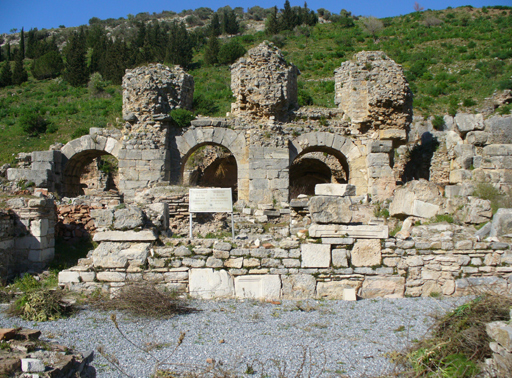 The Varius Baths, dating to the 2nd century AD.
The Varius Baths, dating to the 2nd century AD.
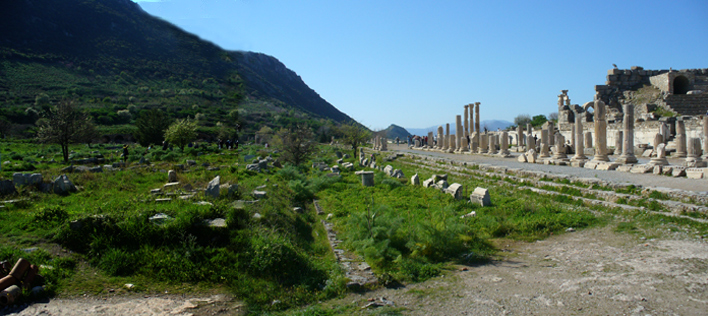
The State Agora to the left and the remaining pillars of a 1st c. AD basilica stoa to the right.
 A look along the Basilica stoa (porch), which was likely used for judicial and administrative functions.
A look along the Basilica stoa (porch), which was likely used for judicial and administrative functions.
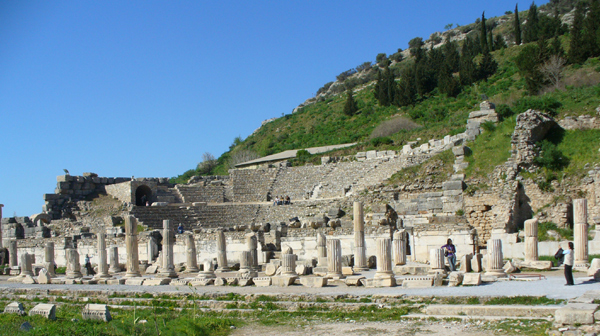 A building which may have served as an odeion (concert hall) or bouleuterion (city council chamber.) Built in the mid 2nd century, it could seat about 1500 people.
A building which may have served as an odeion (concert hall) or bouleuterion (city council chamber.) Built in the mid 2nd century, it could seat about 1500 people.
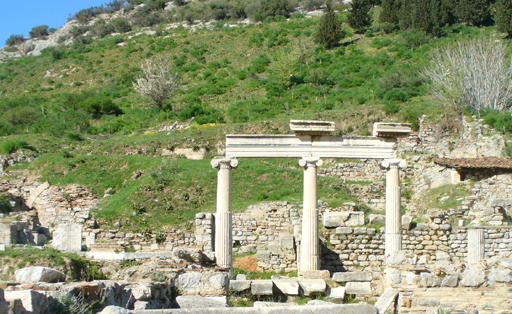 The remains of an altar for Artemis and Augustus.
The remains of an altar for Artemis and Augustus.
 The Prytaneion, where religious ceremonies, official receptions and banquets were held. The sacred flame symbolizing the heart of Ephesus was kept constantly alight in the Prytaneion. The construction of the building dates to the 3rd century B.C.
The Prytaneion, where religious ceremonies, official receptions and banquets were held. The sacred flame symbolizing the heart of Ephesus was kept constantly alight in the Prytaneion. The construction of the building dates to the 3rd century B.C.
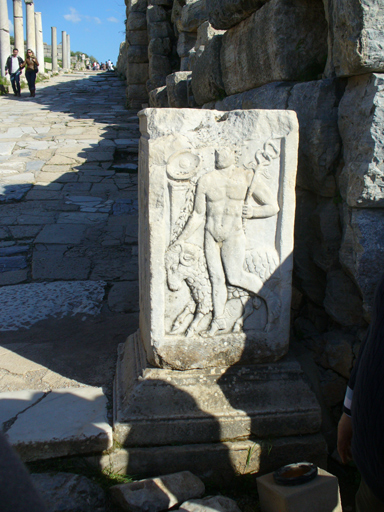 At Domitian Square is a block with a relief of Hermes.
At Domitian Square is a block with a relief of Hermes.
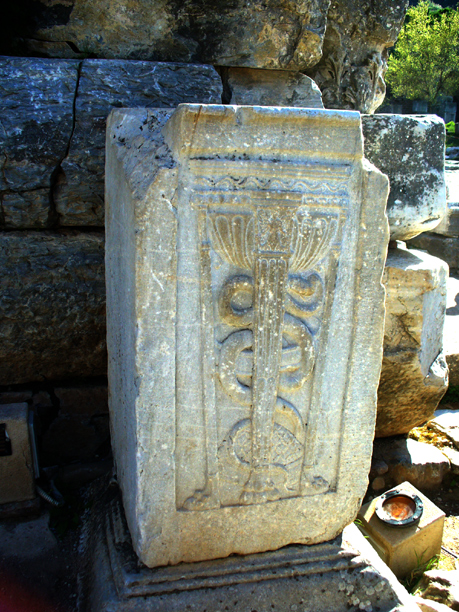
On another side was a relief of a snake and the caduceus, both symbols for medicine. During the Roman Empire, Ephesus housed an important school of medicine.
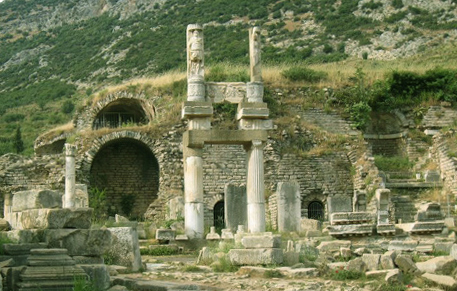 Our guide Rashid pointed out the Temple of Domitian to us. Domitian was the ruler who had banished St. John to the island of Patmos.
Our guide Rashid pointed out the Temple of Domitian to us. Domitian was the ruler who had banished St. John to the island of Patmos.

Off to the side was the Fountain of Pollio. An aqueduct was constructed between 7-15 AD on orders by Sextilius Pollio. The aqueduct was almost two miles in length and brought water from Marnas to the large fountain here in Ephesus.
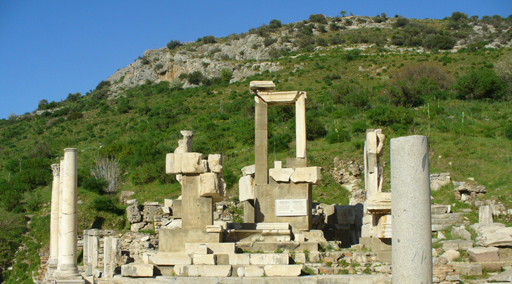 The tomb of Memmius, built in the last half of the 1st century BC to honor Caius Memmius, the grandson of the Roman dictator Sulla.
The tomb of Memmius, built in the last half of the 1st century BC to honor Caius Memmius, the grandson of the Roman dictator Sulla.
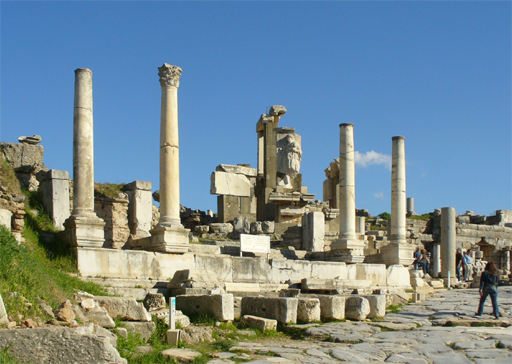 A side view of this monument.
A side view of this monument.
 A view down Curetes street towards the Library.
A view down Curetes street towards the Library.
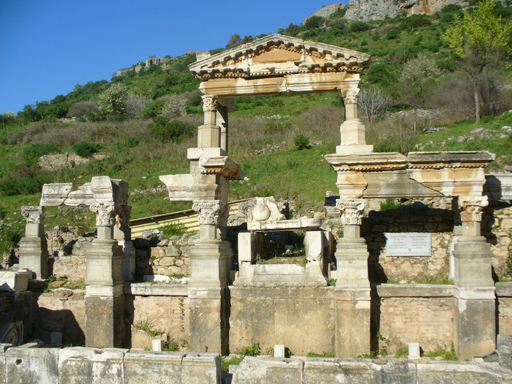 This is the Fountain of Trajan, built to honor the emperor after his visit to Ephesus between 102 and 104 AD. In the center was a statue of Trajan, twice life size. One of the feet of this statue has survived and has been placed in its original position. It is pictured below.
This is the Fountain of Trajan, built to honor the emperor after his visit to Ephesus between 102 and 104 AD. In the center was a statue of Trajan, twice life size. One of the feet of this statue has survived and has been placed in its original position. It is pictured below.

 To the left of the road were some terrace houses with this beautiful mosaic floor outside.
To the left of the road were some terrace houses with this beautiful mosaic floor outside.
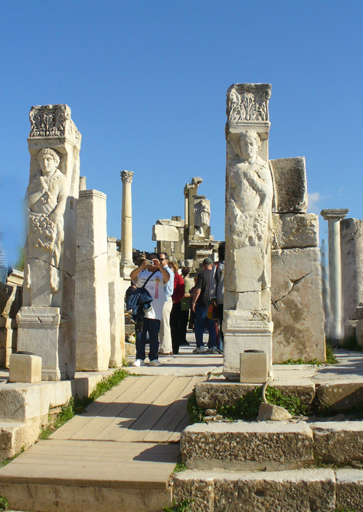 The Hercules gate, so called because of the relief of Hercules on it. It was brought from another place in the fourth century AD to its current place, but the relief on it dates back to the second century AD.
The Hercules gate, so called because of the relief of Hercules on it. It was brought from another place in the fourth century AD to its current place, but the relief on it dates back to the second century AD.
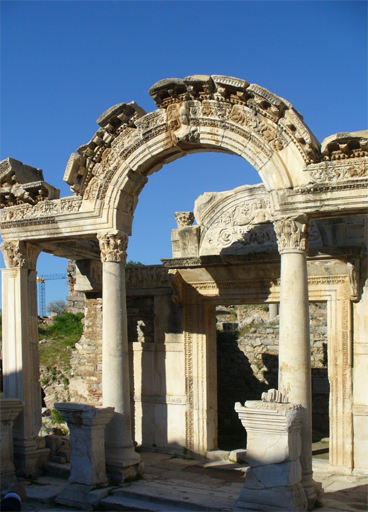 The gate of Hadrian, built in the 2nd century BC.
The gate of Hadrian, built in the 2nd century BC.
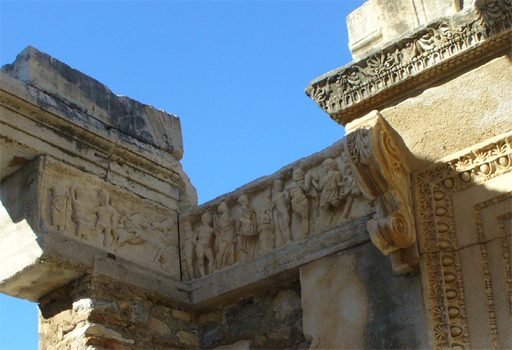 The frieze inside the gate. The originals are in the Ephesus Museum and we will see them later.
The frieze inside the gate. The originals are in the Ephesus Museum and we will see them later.
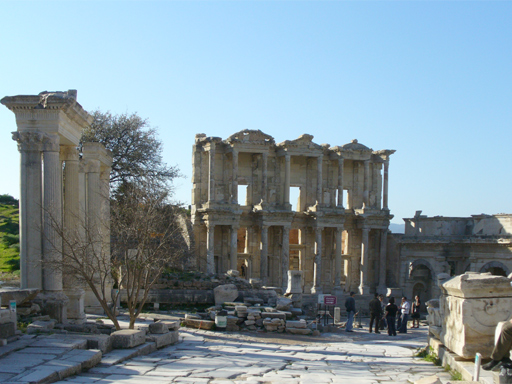 The library of Celsus, built in 117 A.D. It was a monumental tomb for Gaius Julius Celsus Polemaeanus, the governor of the province of Asia; from his son Galius Julius Aquila.
The scrolls of the manuscripts were kept in cupboards in niches on the walls. There were double walls behind the bookcases to protect them from the extremes of temperature and humidity. The capacity of the library was more than 12,000 scrolls. It was the third richest library in ancient times after the Alexandra and Pergamum.
The library of Celsus, built in 117 A.D. It was a monumental tomb for Gaius Julius Celsus Polemaeanus, the governor of the province of Asia; from his son Galius Julius Aquila.
The scrolls of the manuscripts were kept in cupboards in niches on the walls. There were double walls behind the bookcases to protect them from the extremes of temperature and humidity. The capacity of the library was more than 12,000 scrolls. It was the third richest library in ancient times after the Alexandra and Pergamum.
 The facade of the library has two stories, with Corinthian style columns on the ground floor and three entrances to the building. There are three windows openings in the upper story. They used an optical trick that the columns at the sides of the facade are shorter than those at the center, giving the illusion of the building being greater in size.
The facade of the library has two stories, with Corinthian style columns on the ground floor and three entrances to the building. There are three windows openings in the upper story. They used an optical trick that the columns at the sides of the facade are shorter than those at the center, giving the illusion of the building being greater in size.

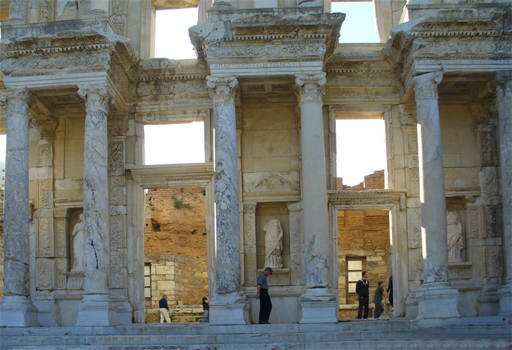
The statues in the niches of the columns today are copies of the originals. The statues symbolize wisdom (Sophia), knowledge (Episteme), intelligence (Ennoia) and valor (Arete). These are the virtues of Celsus.
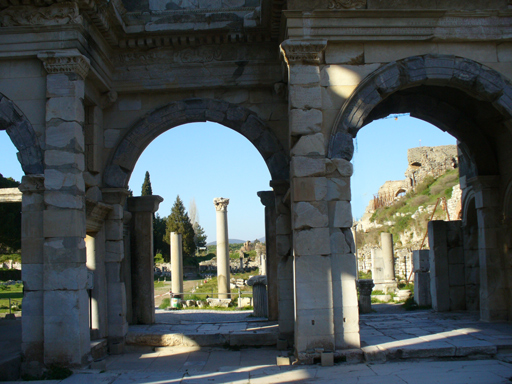 Gates built by two wealthy feedmen in honor of Emperor Augustus. This gate leads to the Square Agora, the major commercial agora of Ephesus.
Gates built by two wealthy feedmen in honor of Emperor Augustus. This gate leads to the Square Agora, the major commercial agora of Ephesus.
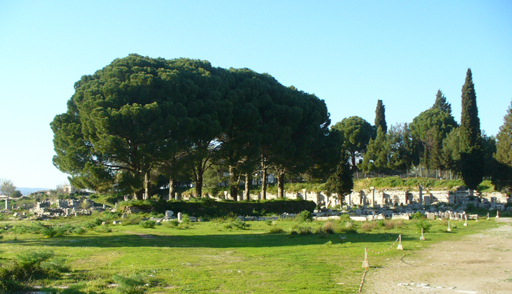 The agora forms a square, nearly 370 feet long on each side, and was surrounded on all four sides by double-columned stoas that apparently had two stories.
The agora forms a square, nearly 370 feet long on each side, and was surrounded on all four sides by double-columned stoas that apparently had two stories.
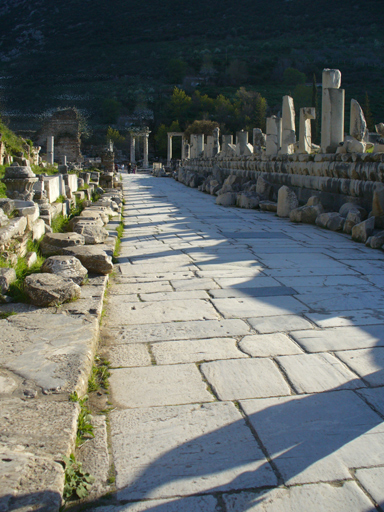 Along one side of the agora is the Marble Road, leading to the theater.
Along one side of the agora is the Marble Road, leading to the theater.
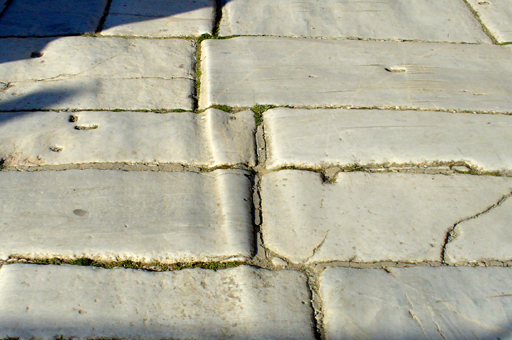 Chariot ruts in the marble street.
Chariot ruts in the marble street.
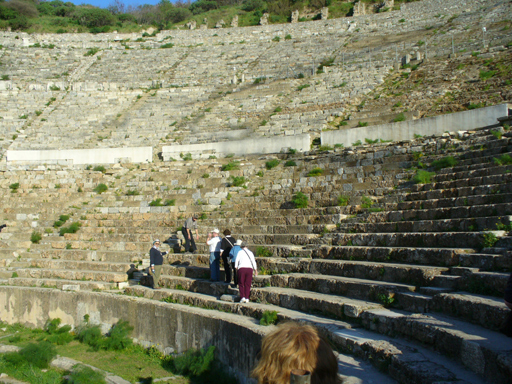 The theater where the followers of Artemis rioted.
The theater where the followers of Artemis rioted.
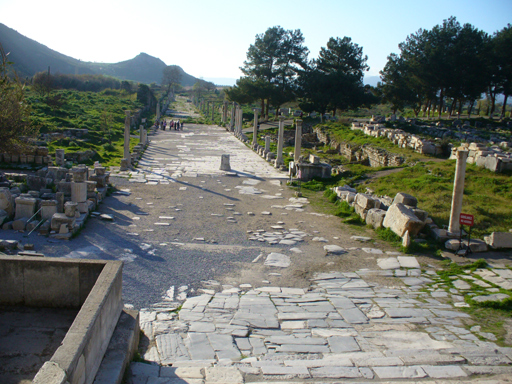 From the theater we could look down Harbor Street, which had led to the harbor before it silted up.
From the theater we could look down Harbor Street, which had led to the harbor before it silted up.
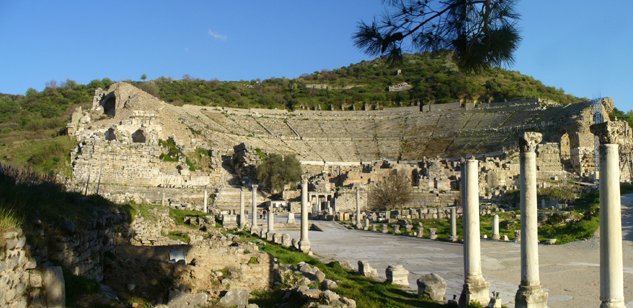 From just above Harbor Street, we had a good view of the theater.
From just above Harbor Street, we had a good view of the theater.
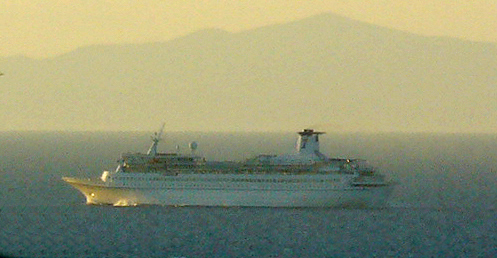 It was a tired group that arrived at our hotel in Kusadasi that evening. From our balcony we could see our ship, the Aquamarine, sail back to Athens.
It was a tired group that arrived at our hotel in Kusadasi that evening. From our balcony we could see our ship, the Aquamarine, sail back to Athens.
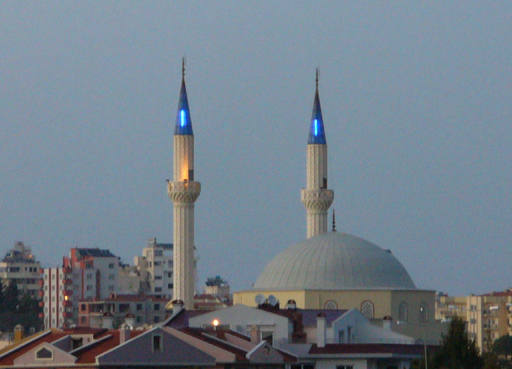 As it was sunset at this time, we also heard our first call to prayer from the minarets on a mosque on a nearby hillside.
As it was sunset at this time, we also heard our first call to prayer from the minarets on a mosque on a nearby hillside.
Our tour will continue tomorrow, going to a Carpet Workshop, the Temple of Artemis and the Ephesus Museum.
